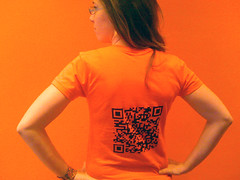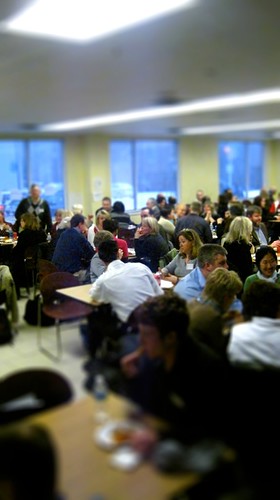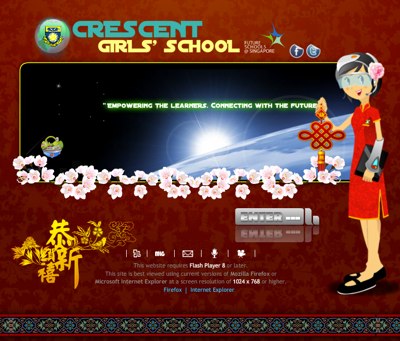During my walk up to the coffee shop yesterday morning (for what I hope to be one of my last writing sessions for the second draft of “A Gardener’s Approach to Learning”) I listened to a CBC podcast, Spark. Hosted by Nora Young, Spark produces not only its radio shows through an RSS feed, but also extended versions of its interviews — and yesterday, I listened to Nora’s conversation with Rob Ennals of Intel Research Berkeley. He, and other scientists, from a variety of settings, are building Dispute Finder, now in beta and downloadable as a Firefox extension.
Dispute Finder
Skeptical Readers
- Install the Dispute Finder Extension
- The extension highlights sentences that make disputed claims
- Click on a cliam to see web articles that support other points of view
Activists
- Install the Dispute Finder Extension
- Add a disputed claim to the Dispute Finder database
- Show Dispute Finder how to find sentences that make that claim on the Web
- Give Dispute Finder arguments for other points of view
- Skeptical Readers will now be told that this claim is disputed when they read a page that contains text that resembles a paraphrase of the disputed claim. ((“About.” Dispute Finder: Reveal the other side of the story. Web. 18 Feb 2010. <http://disputefinder.cs.berkeley.edu/thinklink/>.))
|
With Disput Finder installed (see steps to the right right) you can be instantly notified if the information you are reading has another side, is disputed in some way by somebody or source of authority — and if the questionable text has been identified already. Dispute Finder is intended to become a technical solution to the challenges of finding reliable information on the Internet.
Ennals stated, in the interview, that Dispute Finder is not “the solution” to biased and otherwise less than accurate information. But he continued to describe the product as an assembly of disputed facts, claims, issues, and arguments that is growing out of the crowd sourcing features of the extension. You read something that you know to be disputed, highlight it, and link to the alternative information.
I have to admit some skepticism about the tool, as it was described in the interview. I question whether a community of users can make a dent in the ocean of opinions, spin, lies, and propagation of lies on the Internet. It also concerns me that technical add-ons like Dispute Finder might become a crutch, seen to relieve us from the responsibility of critically evaluating the messages that we encounter. But who would have thought that Wikipedia could ever become what it is today?
Skepticism expressed, I think that this sort of tool is very important — because we are all very busy. We do not have the time, even when we do have the skills, to fact-check every piece of information that might influence us — which brings me to a little controversy that has recently erupted in my state.
The North Carolina Department of Public Instruction (DPI), our state education agency (and my employer from 1990 to 1995, for the sake of full disclosure) is constantly revising elements of the NC Standard Course of Study. Draft 1 of the proposed Social Studies standards, written by a team of practicing Social Studies teachers, has gone out, input has been collected from other Social Studies teachers, a public online survey has been coordinated by the department, and..
..more than 7000 e-mails delivered from caring citizens, not all of them from North Carolinian.
What a dramatic display of citizenship, and I do not mean that sarcastically. I am proud of the response, though I am concerned at what might have contributed to such an impressive civic expression.
First of all, the charge given to the curriculum writing team and the intent of its work “..was to enable our students to learn, in depth, key historical concepts.” ((“Social Studies.” North Carolina Department of Public Instruction. NCDPI, Web. 18 Feb 2010. <http://dpi.state.nc.us/curriculum/socialstudies/>.))
DPI’s chief academic officer, Rebecca Garland, in a recent interview, added
..to teach (History) where students are connected to it, where they see the big idea, where they are able to make connections and draw relationships between parts of our history and the present day. ((Henneberg, Molly. “North Carolina Schools May Cut Chunk Out of U.S. History Lessons.” FoxNews.com 3 Feb 2010: n. pag. Web. 18 Feb 2010. <http://www.foxnews.com/story/0,2933,584758,00.html?mep>.))
That quote was preceded by Garland’s retort that DPI is, “..certainly not trying to go away from American history.”
You see, even with access to a clear description of the changes proposed in Draft 1 of the Social Studies revisions, and an extended satellite interview with Dr. Garland, FoxNews.com opened a February 3 article with,
He may be the president who governed during the Civil War, freeing the slaves, but under a new curriculum proposal for North Carolina high schools, U.S. history would begin years after President Lincoln, with the presidency of Rutherford B. Hayes in 1877.
A picture of government over-reaching is painted by FN reporter, Molly Henneberg, in North Carolina Schools May Cut Chunk Out of U.S. History Lessons, by drastically limiting the scope of its reporting to only two changes, the creation of a new U.S. History course, beginning at 1877, and the coverage of environmental issues in the Global Studies course.
| A study of U.S. history from 1877 to present does not necessarily limit the learning to those years. A teacher could easily assign each student, as an ongoing project, to research and become expert in specific decades prior to 1877, prominent personalities, events, or become experts in the histories of other contemporary countries. Students’ expertise could be called upon throughout the year.
What happened to our faith that teachers will do their jobs? |
The implied accusation, made blatant by the title, is a government working to devalue history and the social studies, to discredit the nation’s founding fathers, and replace hard history with tree-hugging environmentalism. She reports this, while documents on the DPI web site, plainly available to the FoxNews author, describe the educator team’s work to dramatically expand history and the social studies by adding:
- U.S. History to the 5th grade,
- A full year of U.S. History in middle school, in addition to the existing North Carolina History course, and
- Addressing a wide range of issues in a global studies course, including (democratic regimes; peace & stability; causes & effects of globalization; investment, innovation, & technology; human rights; the environment; natural resources; ideologies, philosophies, values, and religion; and global economy).
- And finally, a new U.S. history course that focuses on a deeper exploration of the last 133 years of the nation’s history.
I won’t say that the this Draft revision is perfect. I do not believe that it is. I have a personal bias that emphasizing U.S. History, at the expense of studying history in other parts of the world is a bit arrogant, especially when so many of us are working for Japanese, German, and Canadian companies, working beside colleagues from India, and investing our savings in China. But we’ve got to work in Math, Science, Health, and Literature somewhere.
I can’t help but wonder what civics lesson high school students might be learning right now, when FoxNews reports only those parts of an issue that will generate the most negative emotional energy? What if all history teachers ask their students to compare the reporting of Henneberg’s story and the dozen or so echoing pieces in town papers throughout North Carolina and other states, with the facts published in the NC Department of Public Instruction’s web site? What lesson might students take away about history — and how and who is writing it?
As a former History teacher, I believe that knowing your historic heritage and that of others is critical — that a huge part of being literate in today’s information landscape involves approaching your reading with a sound historic, cultural, political, economic, and environmental context. Without a basis for evaluation, it’s just grazing.














